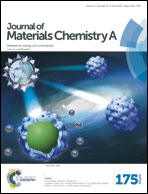First-principles design of a borocarbonitride-based anode for superior performance in sodium-ion batteries and capacitors†
Abstract
Three fundamental challenges for the development of technologically relevant sodium-ion batteries (SIB) and sodium-ion capacitors (SIC) are the lower cell voltage, decreased ionic-diffusivity and larger volume of sodium-ions relative to their lithium-ion analogues. Using first-principles computation, we show that two-dimensional BxCyNz with nitrogen-excess trigonal BxNz-domain (TN) meets the requirements of a superior anode for SIB. Variation in the shape of the BxNz-domain and B–N charge-imbalance in BxCyNz results in tunable anodic properties. Monolayer TN-sheet can store Na(Li) up to Na2.2C6(Li1.8T6) composition, which corresponds to a specific capacity as high as 810(668) mA h g−1 for SIB(LIB). The average open circuit voltage is ∼1.25 V vs. Na/Na+ for a wide range of chemical stoichiometries of NaxTN, which is also beneficial to the overall cell-voltage. The enhanced electronic transport and fast diffusion kinetics of the Na-ions is particular for the TN-anode, which can result in high power efficiency in SIB, even better than that of graphite electrode in conventional LIB. Charge-storage upon layer-wise accumulation of Na-ions on the TN surface is also appealing for application to sodium-ion capacitors, as an alternative to lithium-ion capacitors. These features are in contrast to conventional layered materials, where the voltage drops quickly as Na-ions are removed from the matrix. Hence, this article may serve as a guide for designing borocarbonitride electrodes for SIB(SIC) with controlled experimental behaviour.


 Please wait while we load your content...
Please wait while we load your content...